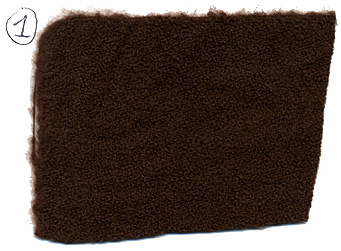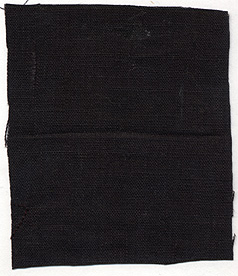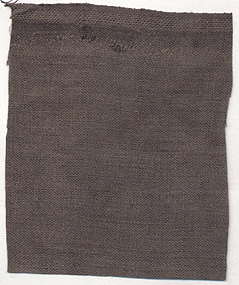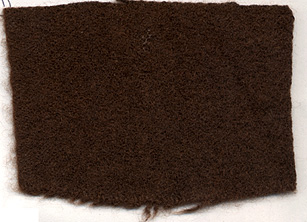1.dye on white wool

Ingredients:
12 oz wool & linen combined. (3/4 lb)
6 oz powdered oak galls
6 oz powdered walnut hulls
3 oz copperas
Process:
Combine gall nut powder and walnut hulls in 5 gal. water. Boil. Let sit 2 hours.
Add copperas to 5 gal water. boil.
Wet wool, enter into gall/walnut vat. Stir for half an hour. Let sit for half an hour.
Rinse wool. At this point the linen is khaki coloured, the wool is a light to medium brown.
Enter into the copperas vat. Stir for 1/2 hour. rinse. At this point the wool and linen looks steel grey when wet. It dries to a light grey.
Put back into the gall walnut vat, which is no longer boiling. Stir for 1/2 hour. Let it sit for 6 hours. Rinse.
Put back into the iron vat. Stir for 15 mins, let it sit for 1 hour. Rinse. At this point the wool is a dull dark brown, the linen looks black when wet.
Put back into the tannin vat for four hours. Rinse.
Place into the iron vat for 2 hours. Rinse.
At this point the linen is a dark black. The wool remains dark brown.
Notes:
I redacted this recipe from a number of recipes for making black in the Innsbruck Manuscript,Segreti Per Colori, The Profitable Book, Ziegler's Little Dye Book, and The Whole Art of Dyeing. All involved tannin in the form of oak galls and iron in the form of copperas or iron filings/flakes, or both. I supplemented my recipe with walnut hull powder, as a couple of the recipes did this as well. The iron and tannin in the original recipes was supplemented by alder bark, soot, walnut hulls or a generic "black dye".
I used a proportion of 1 part copperas to 2 parts oak gall powder to 2 parts walnut hull powder to 4 parts wool. The oak gall and walnut hulls went into one bath, the copperas into a separate bath. Separate baths were referenced in the period recipes; others combined all ingredients into one dye vat.
The dye did make the fabric much harsher and stiffer, particularly the linen. Once the linen was ironed, it felt starched. The linen turned out a lovely deep black, but the wool remained a dark brown.
I avoided sticking my hands in the dye, but even the rinse water dyed my hands a dirty grey and sucked all the moisture out of them. This is a very harsh dye. I moisturized my hands several times a day for the next week before they eventually got back to normal.
SAMPLES:
1.dye on white wool

2.dye on white linen

3.single-dip (one tannin, one copperas) on white linen

4.dye on peach (madder/tannin dyed) wool

5.dye on brown wool (walnut-dyed)
